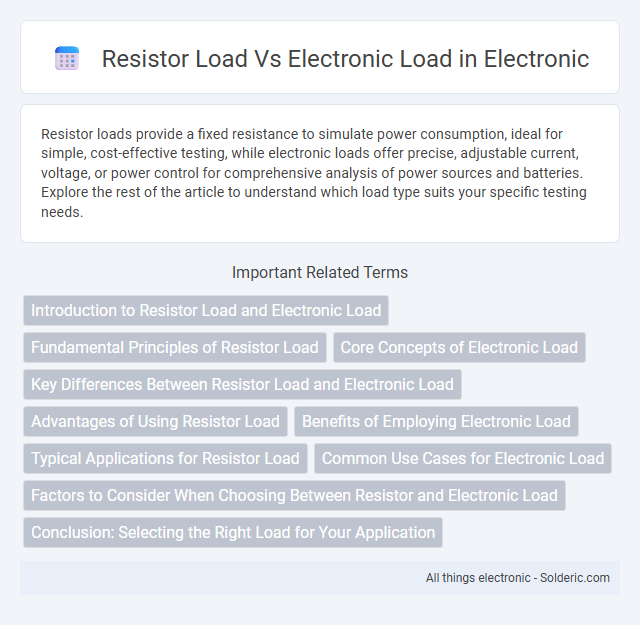Resistor loads provide a fixed resistance to simulate power consumption, ideal for simple, cost-effective testing, while electronic loads offer precise, adjustable current, voltage, or power control for comprehensive analysis of power sources and batteries. Explore the rest of the article to understand which load type suits your specific testing needs.
Comparison Table
| Feature | Resistor Load | Electronic Load |
|---|---|---|
| Functionality | Simple passive load using resistor | Active load with adjustable current/voltage settings |
| Load Control | Fixed, determined by resistor value | Dynamic and programmable load control |
| Accuracy | Limited, depends on resistor tolerance | High precision current and voltage control |
| Heat Dissipation | High heat generation, requires heat sinks | Efficient thermal management with cooling options |
| Usage | Simple testing, low-cost applications | Complex testing, battery testing, power supply characterization |
| Cost | Low cost | Higher initial investment |
| Flexibility | Limited to fixed resistance values | Versatile load modes: constant current, constant voltage, constant power |
Introduction to Resistor Load and Electronic Load
Resistor loads provide a simple, passive method to test power supplies and circuits by dissipating electrical energy as heat through a fixed resistance. Electronic loads, however, offer dynamic and programmable testing capabilities, simulating various real-world conditions such as constant current, voltage, or power modes. Your choice between resistor and electronic loads depends on the precision and flexibility required for accurate measurement and device characterization.
Fundamental Principles of Resistor Load
Resistor loads operate based on the fundamental principle of converting electrical energy into heat through a fixed resistance, following Ohm's law where voltage and current are linearly related. This simplicity allows for predictable and stable load behavior, making resistor loads ideal for testing power supplies and circuits under consistent conditions. Your choice of resistor load ensures precise power dissipation control without the complexity of electronic feedback mechanisms found in electronic loads.
Core Concepts of Electronic Load
Electronic loads offer precise control over current, voltage, and power, enabling dynamic testing of power supplies and batteries beyond the fixed resistance of resistor loads. They use semiconductor components to simulate various load conditions, providing real-time feedback and adjustable parameters for accurate performance evaluation. Your testing efficiency improves significantly with electronic loads due to their programmability, versatility, and ability to replicate complex load behaviors.
Key Differences Between Resistor Load and Electronic Load
Resistor loads provide a fixed, non-adjustable resistance that dissipates power as heat, making them simple and reliable for basic testing scenarios. Electronic loads offer precise, adjustable current, voltage, or power settings with advanced features like dynamic loading and programmable test sequences, ideal for simulating real-world operating conditions. Your choice depends on whether you need fixed resistance simplicity or versatile, controlled load testing.
Advantages of Using Resistor Load
Resistor loads provide a simple, reliable, and cost-effective method for testing power supplies and batteries by dissipating energy as heat with minimal complexity. Their stable resistance ensures predictable and consistent load conditions, making them ideal for basic load testing and circuit debugging. Your application benefits from the ease of use and durability of resistor loads, especially in environments where precise electronic control is not required.
Benefits of Employing Electronic Load
Electronic loads offer precise control over current, voltage, and power, enabling dynamic and accurate testing of power supplies and batteries. Their programmable features allow simulation of real-world operating conditions, improving the reliability and efficiency of your device evaluations. Unlike resistor loads, electronic loads reduce energy waste and provide enhanced safety with built-in protection mechanisms.
Typical Applications for Resistor Load
Resistor loads are commonly used in power supply testing, battery discharge tests, and basic circuit load simulation due to their simplicity and reliability. They provide a fixed resistance that dissipates energy as heat, making them ideal for applications requiring steady, predictable loads. Unlike electronic loads, resistor loads lack adjustable parameters, limiting their use primarily to constant load scenarios in design validation and equipment calibration.
Common Use Cases for Electronic Load
Electronic loads are commonly used in testing and validating power supplies, batteries, and solar panels by simulating real-world electrical loads with precise control over current, voltage, and power dissipation. They enable dynamic testing of power devices and circuits under various operating conditions, including constant current, constant voltage, constant power, and constant resistance modes. Unlike resistor loads, electronic loads provide flexibility and programmability, essential for automated testing environments and performance characterization in research and development.
Factors to Consider When Choosing Between Resistor and Electronic Load
When choosing between resistor loads and electronic loads, consider power dissipation, accuracy, and flexibility requirements in your application. Resistor loads offer simplicity and cost-effectiveness for fixed load conditions, whereas electronic loads provide precise control, dynamic adjustment, and protection features essential for complex testing environments. Your decision should factor in the need for load variability, measurement precision, and thermal management capabilities.
Conclusion: Selecting the Right Load for Your Application
Resistor loads provide a simple, cost-effective solution ideal for steady-state testing with predictable heat dissipation, while electronic loads offer precise control and dynamic testing capabilities essential for complex or variable power scenarios. Your choice should depend on the specific requirements of your application, such as power rating, accuracy, and flexibility. Understanding these differences ensures optimized performance and reliability in your testing environment.
Resistor load vs Electronic load Infographic

 solderic.com
solderic.com